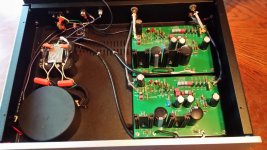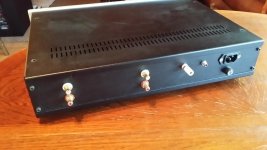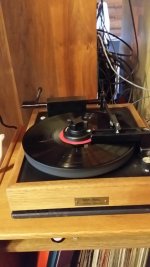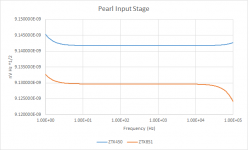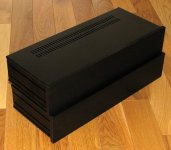I confess to a total lack of context for the "What signals are on records?" graph.
It's part of a technical paper written by the folks from Shure. The statement was made that a vinyl recording will rarely exceed 10mV, but the cartridge manufacturer took pains to demonstrate that levels in excess of 70mV "happen" and that the technology they develop is to encompass these extremes in mechanical terms.
So with regards to the Pearl2, the first stage certainly seems really fine for a moving coil cartridge, and with a moving magnet cart most of the time.
I am not too happy with the second stage...
I made a mistake earlier saying that the first stage gain is 40dB, on mine it's actually 40x
Pass DIY Addict
Joined 2000
Paid Member
Hi everyone,
if I remember the Pearl 2 settings from Waynes notes correctly than Pearl 2 gain is:
1st stage gain (4 x 2SK170 JFETs + ZTX450 cascode) is roughly 35 dB.
Losses in passive RIAA are about 20 dB.
2nd stage gain as per schematic (R16+R14)/R14 is roughly 40 dB.
Total Pearl 2 gain by default should be 55 dB.
Cheers
Poli
if I remember the Pearl 2 settings from Waynes notes correctly than Pearl 2 gain is:
1st stage gain (4 x 2SK170 JFETs + ZTX450 cascode) is roughly 35 dB.
Losses in passive RIAA are about 20 dB.
2nd stage gain as per schematic (R16+R14)/R14 is roughly 40 dB.
Total Pearl 2 gain by default should be 55 dB.
Cheers
Poli
Hi everyone,
if I remember the Pearl 2 settings from Waynes notes correctly than Pearl 2 gain is:
1st stage gain (4 x 2SK170 JFETs + ZTX450 cascode) is roughly 35 dB.
Cheers
Poli
The first stage gain will be proportionate to 1/(Rs +(1/gm)) of the SK170's. So if you have "lowish" JFETs the gain will be lower.
SK170's gm range from 0.018 to 0.042 Siemens.
Pearl 2 in Pesante Chassis
I built a Pearl 2 in one Pesante chassis trying to get it to fit in the shelf under the turntable. It resulted in no hum or noise at all. Here is some of what I did. I immediately went to a CRC to keep low voltage AC away. Put the inputs on the far side. From lessemf.com I bought a $30 gaussmeter to test for minumum emf. I also bought mucord from them and some mumetal sheets and foil (good source of small qts of mumetal). It turns out I did not need the mumetal for shielding. I used their mucord for AC in and DC to the boards. It did seem to lessen emf. I keep cables low as 6L6 suggested. From ground to earth I used just a 10R resistor and it worked great. I ran a wire from star earth to any panel without continuity. Notice the lid has a conductive copper tape with a wire soldered to it. The xformer is an Antek, either a 25VA 24VAC or a 50VA 22VAC. I cannot remember; I used whatever was in my parts bin.
The turntable is an air bearing Maplenoll which is very quiet to begin with, and a Denon DL-110. I cannot be happier with the sound. It is sooo....well..good (words cannot describe). My sincerest thanks to Wayne and Mr. Pass and 6L6 for the guide.
I built a Pearl 2 in one Pesante chassis trying to get it to fit in the shelf under the turntable. It resulted in no hum or noise at all. Here is some of what I did. I immediately went to a CRC to keep low voltage AC away. Put the inputs on the far side. From lessemf.com I bought a $30 gaussmeter to test for minumum emf. I also bought mucord from them and some mumetal sheets and foil (good source of small qts of mumetal). It turns out I did not need the mumetal for shielding. I used their mucord for AC in and DC to the boards. It did seem to lessen emf. I keep cables low as 6L6 suggested. From ground to earth I used just a 10R resistor and it worked great. I ran a wire from star earth to any panel without continuity. Notice the lid has a conductive copper tape with a wire soldered to it. The xformer is an Antek, either a 25VA 24VAC or a 50VA 22VAC. I cannot remember; I used whatever was in my parts bin.
The turntable is an air bearing Maplenoll which is very quiet to begin with, and a Denon DL-110. I cannot be happier with the sound. It is sooo....well..good (words cannot describe). My sincerest thanks to Wayne and Mr. Pass and 6L6 for the guide.
Attachments
I don't think that you'd be able to hear the difference, but if you substitute ZTX851 for Q1 and Q3 (ZTX450) you might improve the front-end noise a bit.
The biggest factor informing noise is the paralleled njfets, the second seems to be the R7 bypass cap of 3,300u.
The biggest factor informing noise is the paralleled njfets, the second seems to be the R7 bypass cap of 3,300u.
Attachments
Power Supply Caps - What are people using
I received my boards from Pass DIY and am collecting parts.
I have a good idea on most of the parts I want to use but am trying to figure out what E-caps to use in the PSU and on the board.
The choices are somewhat limited due to size constraints (diameter).
I'm leaning towards Nichicon LKG, LKS or UKW/KW.
Any suggestions or experiences with what people have used would be greatly appreciated.
I received my boards from Pass DIY and am collecting parts.
I have a good idea on most of the parts I want to use but am trying to figure out what E-caps to use in the PSU and on the board.
The choices are somewhat limited due to size constraints (diameter).
I'm leaning towards Nichicon LKG, LKS or UKW/KW.
Any suggestions or experiences with what people have used would be greatly appreciated.
Craigtone:Woot! Chassis arrived today!
I feel pretty ... oh so pretty ... 😀
What chassis did you use on your Pearl 2 ?
Need some help, please.
One channel went dead (due to statics, I guess) and
I try to debug which part(s) went south.
Q1 or Q3 or both?
Fingers crossed it's not input fets.
Please, find the voltages of both working (left) and dead (right) channels attached.
One channel went dead (due to statics, I guess) and
I try to debug which part(s) went south.
Q1 or Q3 or both?
Fingers crossed it's not input fets.
Please, find the voltages of both working (left) and dead (right) channels attached.
Attachments
Need some help, please.
One channel went dead (due to statics, I guess) and
I try to debug which part(s) went south.
Q1 or Q3 or both?
Fingers crossed it's not input fets.
Please, find the voltages of both working (left) and dead (right) channels attached.
Hello Siberia,
My guess Q1 dead for sure. Not sure about Q2.
Change Q1 and power up to see if better. If not, change Q2 too.
Then re check again. If still nothing ok, might be the quad but unlikely
Best,
nAr
i wonder if that trick in one of ADI's APP Notes to reduce leakage generated noise in electrolytic caps would be of any use here ? ....
mlloyd1
edit:
Link to doc and page number added:
OP176 datasheet
Look at page 13, figure 41 and read the write-up.
mlloyd1
edit:
Link to doc and page number added:
OP176 datasheet
Look at page 13, figure 41 and read the write-up.
...
the second seems to be the R7 bypass cap of 3,300u.
Last edited:
Need some help, please.
Please, find the voltages of both working (left) and dead (right) channels attached.
I just measured my Pearl
24.2 at collector of Q1,
20.5 at emitter of Q1
7.56 at base of Q3
6.87 at emitter of Q3
0.070 at source of JFETs
you have over 6.4mA flowing through the JFETs so you should be getting an output.
Isn't R10 supposed to be 10K?
i wonder if that trick in one of ADI's APP Notes to reduce leakage generated noise in electrolytic caps would be of any use here ?
gets us into another topic -- we need those megabuck wet slug tantalums with extremely low leakage.
Siberia,
Just curious, why did u parallel a 6.8k||10k for R10?
Sent from my XT1575 using Tapatalk
Just curious, why did u parallel a 6.8k||10k for R10?
Sent from my XT1575 using Tapatalk
Hi Jack,
Those wet slug tantalum capacitors are fantastic for small spaces, and excellent quality. You just need a bank loan to get a few. Last time I looked, they were running $35 and up a piece. Something you really ought to need rather than sprinkling them about in hopes of better sound.
They seem to last forever though, the one plus about caps of that cost.
-Chris
Those wet slug tantalum capacitors are fantastic for small spaces, and excellent quality. You just need a bank loan to get a few. Last time I looked, they were running $35 and up a piece. Something you really ought to need rather than sprinkling them about in hopes of better sound.
They seem to last forever though, the one plus about caps of that cost.
-Chris
Thanks, Nar, Jack, mlloyd1.
@aoc the reason for lowering R10 was getting closer to Wayne's voltages around Q3 and on the input fets. Done by quite some members here and learned on this thread.
@aoc the reason for lowering R10 was getting closer to Wayne's voltages around Q3 and on the input fets. Done by quite some members here and learned on this thread.
The idea originates with the late Jim Williams:Hi Jack,
Those wet slug tantalum capacitors are fantastic for small spaces, and excellent quality. You just need a bank loan to get a few. Last time I looked, they were running $35 and up a piece. Something you really ought to need rather than sprinkling them about in hopes of better sound.
They seem to last forever though, the one plus about caps of that cost.
-Chris
http://cds.linear.com/docs/en/application-note/an124f.pdf
Need some help, please.
One channel went dead (due to statics, I guess) and
I try to debug which part(s) went south.
Q1 or Q3 or both?
Fingers crossed it's not input fets.
Please, find the voltages of both working (left) and dead (right) channels attached.
Hello Siberia,
My guess Q1 dead for sure. Not sure about Q2.
Change Q1 and power up to see if better. If not, change Q2 too.
Then re check again. If still nothing ok, might be the quad but unlikely
Best,
nAr
Similar experience. Right channel was perfect from get go, and Left worked just as well once Q3 ZVP450 was replaced. Vinyl joy until Right channel became noisy - sounds like curtains rustling - then died, came back and dead again. Approx 23v on the DC offset (ie way too high), 3.3v across R6 (cf 1.5v on working channel) and 9.3v between R6 and Q4 2SK370 (cf required 21v). Have replaced Q2 and Q11 to no avail. Q11 ZTK450 gets quite hot.
This is my first crack at solid state, more used to basic valve guitar amp builds. Would very much appreciate thoughts. I'm hoping it's not a JFET!
- Home
- Amplifiers
- Pass Labs
- Pearl Two
